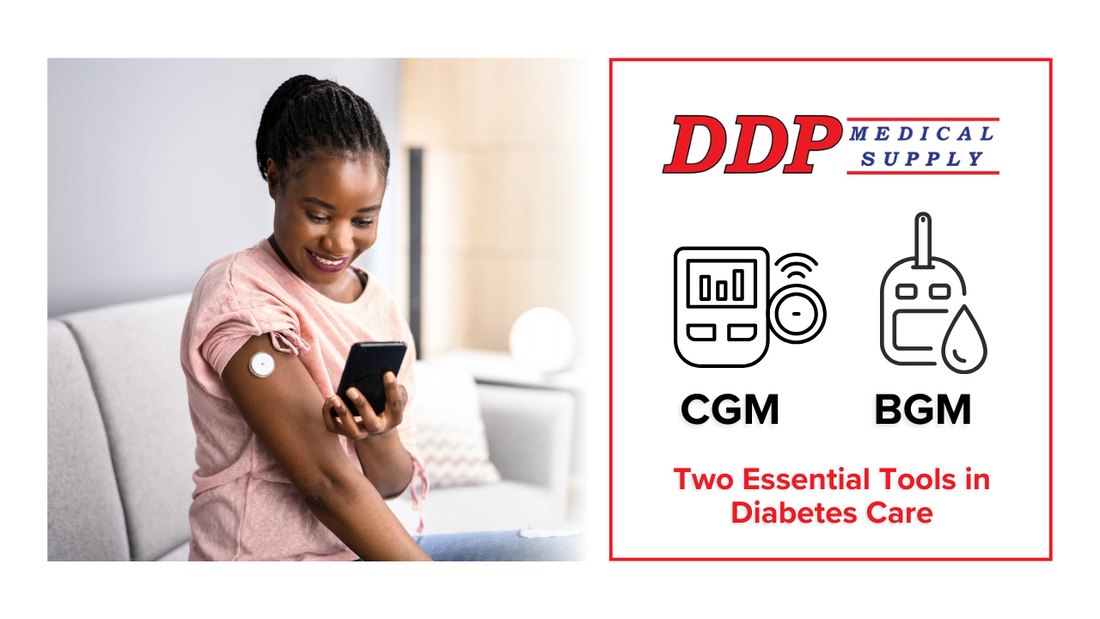
CGM & BGM – Two Essential Tools in Diabetes Care
Share
Blood Glucose Monitoring (BGM)—often called fingersticks—has been the go-to method for people managing diabetes for decades. It’s simple, accessible, and remains essential in many care plans. In recent years, Continuous Glucose Monitoring (CGM) has emerged as a complementary option, offering continuous data, proactive alerts, and trend insights that can inform daily decisions.
“Technology-supported diabetes care isn’t just the future—it’s the present. CGM gives providers and patients the tools to act in real time and improve long-term outcomes.”
Understanding the Two Approaches
What Is BGM?
BGM involves pricking the finger and using a glucose meter with a test strip to measure blood sugar.
What Is CGM?
CGM uses a small, wearable sensor to automatically track glucose 24/7. Readings are sent to a smartphone or receiver, showing patterns, trends, and alerts for highs and lows. CGM can be particularly helpful for patients who want proactive alerts, fewer fingersticks, or closer monitoring.
How They Work Together
In many care plans, CGM and BGM are complementary. CGM users may still perform occasional fingersticks to confirm readings or follow clinical guidance. The right mix depends on a patient’s goals, medication regimen, and provider recommendations.
| Feature | BGM (Blood Glucose Monitoring) | CGM (Continuous Glucose Monitoring) |
|---|---|---|
| ⏱ Frequency | Manual testing on demand | Automatic readings every 1–5 minutes |
| 📉 Data Trends | Single reading at the time of testing | Tracks continuous patterns and trends |
| 🚨 Alerts | No built-in alerts | Can warn of highs/lows in advance |
| 🌐 Remote Monitoring | Not typically connected for remote access | Enables sharing data with providers/caregivers |
Table shows monitoring frequency, data depth, proactive alerts, and remote-care readiness.
Clinical Evidence: Outcomes that Matter
A growing body of clinical research supports the use of CGM as a standard tool for improving diabetes outcomes. According to the American Diabetes Association, CGMs can help reduce A1C, lower the risk of severe hypoglycemia, and increase time-in-range (TIR)—a key metric for daily glucose control.
One ADA newsroom report highlighted that CGM users spent 17% more time in range compared to those relying on self-monitoring of blood glucose (SMBG)—nearly 4 extra hours per day in safer glucose levels (ADA newsroom).
“The real-time data and alerts offered by CGM systems allow for more informed and timely decision-making, leading to better glycemic control.”
Coverage & Access
Both BGM and CGM supplies may be covered by Medicare and commercial insurance plans when medically necessary. CGM coverage has expanded significantly, with widely reimbursed systems from major manufacturers.
Explore popular options: Abbott FreeStyle Libre 3 Plus • Dexcom G7
Conclusion
BGM and CGM are both critical tools in modern diabetes care. While CGM offers additional data and convenience for many, BGM continues to be essential—and often complements CGM within a patient’s care plan.
DDP Medical Supply supports providers and patients with both technologies, ensuring the right solution for every care scenario.


